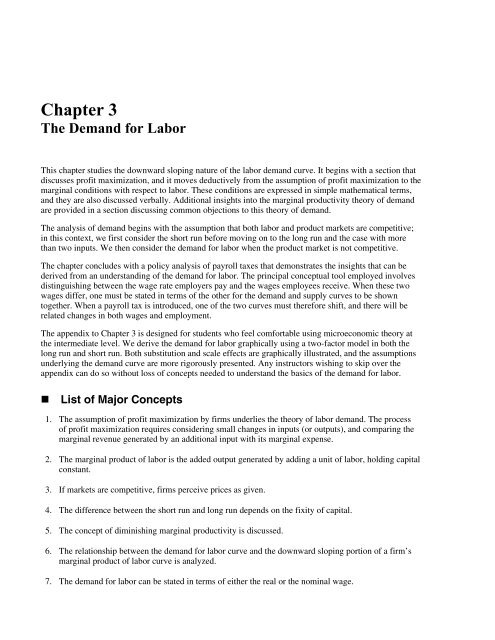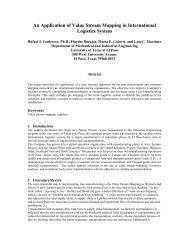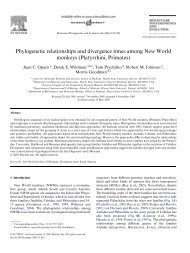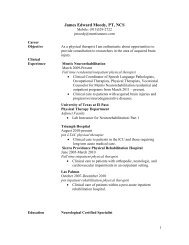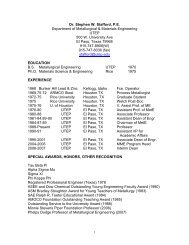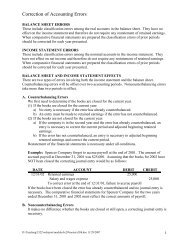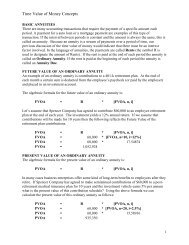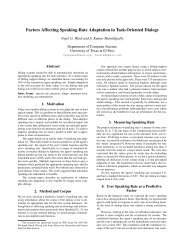Homework For Assignment 2 (Chapter 3)
Homework For Assignment 2 (Chapter 3)
Homework For Assignment 2 (Chapter 3)
- No tags were found...
You also want an ePaper? Increase the reach of your titles
YUMPU automatically turns print PDFs into web optimized ePapers that Google loves.
<strong>Chapter</strong> 3The Demand for LaborThis chapter studies the downward sloping nature of the labor demand curve. It begins with a section thatdiscusses profit maximization, and it moves deductively from the assumption of profit maximization to themarginal conditions with respect to labor. These conditions are expressed in simple mathematical terms,and they are also discussed verbally. Additional insights into the marginal productivity theory of demandare provided in a section discussing common objections to this theory of demand.The analysis of demand begins with the assumption that both labor and product markets are competitive;in this context, we first consider the short run before moving on to the long run and the case with morethan two inputs. We then consider the demand for labor when the product market is not competitive.The chapter concludes with a policy analysis of payroll taxes that demonstrates the insights that can bederived from an understanding of the demand for labor. The principal conceptual tool employed involvesdistinguishing between the wage rate employers pay and the wages employees receive. When these twowages differ, one must be stated in terms of the other for the demand and supply curves to be showntogether. When a payroll tax is introduced, one of the two curves must therefore shift, and there will berelated changes in both wages and employment.The appendix to <strong>Chapter</strong> 3 is designed for students who feel comfortable using microeconomic theory atthe intermediate level. We derive the demand for labor graphically using a two-factor model in both thelong run and short run. Both substitution and scale effects are graphically illustrated, and the assumptionsunderlying the demand curve are more rigorously presented. Any instructors wishing to skip over theappendix can do so without loss of concepts needed to understand the basics of the demand for labor.• List of Major Concepts1. The assumption of profit maximization by firms underlies the theory of labor demand. The processof profit maximization requires considering small changes in inputs (or outputs), and comparing themarginal revenue generated by an additional input with its marginal expense.2. The marginal product of labor is the added output generated by adding a unit of labor, holding capitalconstant.3. If markets are competitive, firms perceive prices as given.4. The difference between the short run and long run depends on the fixity of capital.5. The concept of diminishing marginal productivity is discussed.6. The relationship between the demand for labor curve and the downward sloping portion of a firm’smarginal product of labor curve is analyzed.7. The demand for labor can be stated in terms of either the real or the nominal wage.
<strong>Chapter</strong> 3 The Demand for Labor 138. The relationship between the demand curve of individual firms and the market demand curve isbriefly discussed.9. Two principal objections to the marginal productivity theory of labor demand are presented anddiscussed.10. The conditions for profit maximization with respect to capital are relevant in the long run, andadjustments of capital to changes in relative prices generate substitution effects on employment.11. Generalizing to more than two inputs, the demand for one grade of labor is influenced by the wagesof other grades of labor.12. The concepts of substitutes in production, gross substitutes, complements in production, and grosscomplements are defined and related.13. Product market monopoly affects the profit maximization conditions, and thus the demand for labor.14. The imposition of payroll taxes on the employer will shift the demand for labor curve (when drawn asa function of employee wages) to the left, causing worker wages and/or employment levels to fall.15. (Appendix) The graphical depiction of a production function is presented.16. (Appendix) The demand for labor in the short run is graphically derived.17. (Appendix) The demand for labor in the long run, showing both substitution and scale effects of awage change, is graphically illustrated.• Answers to Even-Numbered Review Questions2. Assume that wages for keyboarders (data entry clerks) are lower in India than in the United States.Does this mean that keyboarding jobs in the United States will be lost to India? Explain.Answer: Indian data entry clerks will be substituted for American ones only if the ratio of theirwage to their marginal productivity is lower. Thus, it is not wage alone that affects theincentives to substitute; marginal productivity is also critical.4. Suppose that prisons historically have required inmates to perform, without pay, various cleaning andfood preparation jobs within the prison. Now suppose that prisoners are offered paid work in factoryjobs within the prison walls, and that the cleaning and food preparation tasks are now performed bynon-prisoners hired to do them. Would you expect to see any differences in the technologies used toperform these tasks? Explain.Answer: When inmates were required to work without pay, their wage was essentially zero—and wewould expect that prisons to have adopted labor-intensive technologies (using the argumentinherent in Equation 3.8c). When wages rise, the cost of expanding output using laborbecomes greater, and we expect prisons to adopt the use of more capital in the productionprocess.
14 Ehrenberg/Smith • Modern Labor Economics: Theory and Public Policy, Tenth Edition6. Suppose the government were to subsidize the wages of all women in the population by paying theiremployers 50 cents for every hour they worked. What would be the effect on the wage rate womenreceived? What would be the effect on the net wage employers paid? (The net wage would be thewage women received less 50 cents.)Answer: Consider a simple competitive labor market in which the demand and supply of womenare both expressed in terms of the wage received by women (which, in the absence of anysubsidy, is assumed to be equal to the wage paid by employers). Given the demand curve, D 0,and the supply curve, S 0, market clearing wage and employment levels will be W 0and E 0,respectively.Suppose the government now subsidizes employers by paying them 50 cents for every hourwomen work. Viewed in terms of the wage received by women, the employers’ demandcurve will shift up by exactly 50 cents (reflecting the fact that this amount will be paid bythe government). At the old market clearing wage received by women, W 0, the number ofwomen employers want to hire, E 2, exceeds the number who are willing to work, E 0. Thisputs upward pressure on the wage received by women, and this wage rises until the excessdemand for labor is eliminated. This equilibrium occurs at the wage rate W 1, and theemployment level E 1.It is clear from the figure that the wage received by women increases by less than 50 centsas long as the supply of labor curve is not vertical (i.e., as long as labor supply is responsiveto wages). Indeed, the more responsive labor supply is to the wage rate, the less the women’swage will rise. Since the wage paid by employers now equals the wage women receiveless the 50-cent subsidy, it is also clear that the wage paid by employers declines (by 50 centsminus the increase in the wage women receive).It is important to stress to students that one would reach identical conclusions if one analyzedthe subsidy in terms of the wage employers pay. If supply and demand curves are drawn interms of this variable, a 50-cent-an-hour subsidy for women would shift the female laborsupply curve down by 50 cents. At the old wage paid by employers, the supply of femalelabor would now exceed the demand. Downward pressure would be placed on the wage paidby employers and it would fall by less than 50 cents (as long as labor supply was responsiveto the wage). As a result, the wage received by women would rise by 50 cents less the fallin the wage paid by employers.
<strong>Chapter</strong> 3 The Demand for Labor 158. If anti-sweatshop movements are successful in raising pay and improving working conditions forapparel workers in foreign countries, how will these changes abroad affect labor market outcomesfor workers in the apparel and retailing industries in the United States? Explain.Answer: If increased labor costs abroad are not accompanied by increases in marginal productivity,then there will be incentives to substitute for these foreign workers (with capital or workerselsewhere, including the United States). However, increased costs of manufacturing universityapparel also would be expected to reduce sales and the scale of output, which will putdownward pressure on employment in the American apparel and retailing industries. Thepresence of both substitution and scale effects—working in opposite directions—impliesthat the ultimate effect on American workers in these industries cannot be predicted bytheory alone.• Answers to Even-Numbered Problems2. The marginal revenue product of labor in the local saw mill is MRP L = 20 − 0.5L, where L = thenumber of workers. If the wage of saw mill workers is $10 per hour, then how many workers willthe mill hire?Answer: The mill will hire workers until MRP L = W.20 − 0.5L = 10 when L = 20 workers.4. The output of workers at a factory depends on the number of supervisors hired (see below). The factorysells its output for $0.50 each, it hires 50 production workers at a wage of $100 per day, and needs todecide how many supervisors to hire. The daily wage of supervisors is $500 but output rises as moresupervisors are hired, as shown below. How many supervisors should it hire?Supervisors Output (units per day)0 11,0001 14,8002 18,0003 19,5004 20,2005 20,600Answer: The firm needs to compare the marginal cost to the marginal revenue of hiring anadditional supervisor. The marginal cost is always $500 for each extra supervisor. Themarginal revenue is the number of additional units produced times the price of output.Number of Supervisors MC MR1 $500 $0.50 × 3800 = $19002 $500 $0.50 × 3200 = $16003 $500 $0.50 × 1500 = $7504 $500 $0.50 × 700 = $3505 $500 $0.50 × 400 = $200The firm will hire three supervisors since the marginal revenue generated from hiring thethird supervisor exceeds $500 but the marginal revenue generated from hiring the fourthsupervisor is less than $500.
16 Ehrenberg/Smith • Modern Labor Economics: Theory and Public Policy, Tenth Edition6. The table below shows the number of cakes that could be baked daily at a local bakery, depending onthe number of bakers.Number of Bakers Number of Cakes0 01 102 183 234 27a. Calculate the marginal product of labor.b. Do you observe the law of diminishing marginal returns? Explain.c. Suppose each cake sells for $10. Calculate the marginal revenue product of labor.d. Draw the marginal revenue product of labor curve, which is the demand curve for bakers.e. If each baker is paid $80 per day, how many bakers will the bakery owner hire, given that thegoal is to maximize profits? How many cakes will be baked and sold each day?Answer: a.Number of Bakers Number of Cakes MP L MRP L0 0 — —1 10 10 1002 18 8 803 23 5 504 27 4 40The marginal product of labor (MP L ) is calculated in the third column, using thefollowing formula:MP L = Δ(Number of cakes)/ΔLb. Yes, the marginal product of labor declines as more bakers are hired.c. The marginal revenue product of labor (MRP L ) is calculated in the fourth column,using the following formula:MRP L = MP L × P
<strong>Chapter</strong> 3 The Demand for Labor 17d. The demand for labor is the MRP L curve:e. If each baker is paid $80 per day, 2 bakers would be hired and 18 cakes would bebaked and sold daily.8. The demand curve for gardeners is G D = 19 − W, where G = the number of gardeners and W = thehourly wage. The supply curve is G S = 4 + 2W.a. Graph the demand curve and the supply curve. What is the equilibrium wage and equilibriumnumber of gardeners hired?b. Suppose the town government imposes a $2 per hour tax in all gardeners. Indicate the effect ofthe tax on the market for gardeners. What is the effect on the equilibrium wage and the equilibriumnumber of gardeners hired? How much does the gardener receive? How much does the customerpay? How much does the government receive as tax revenue?Answer: a.
18 Ehrenberg/Smith • Modern Labor Economics: Theory and Public Policy, Tenth EditionTo calculate the equilibrium wage and equilibrium quantity:G D = G S19 – W = 4 + 2W15 = 3WW = 5 [equilibrium wage]Next solve for equilibrium quantity:G D = 19 − W = 19 − 5 = 14[equilibrium quantity]b. With the imposition of the tax on gardeners, the new supply is G S = 4 + 2(W − 2).To calculate the equilibrium wage and equilibrium quantity:G D = G S19 − W = 4 + 2(W − 2)19 − W = 2W3W = 19W = 19/3 = 6.33 [equilibrium wage]Next solve for equilibrium quantity:G D = 19 − W = 19 − 6.33 = 12.67[equilibrium quantity]With the imposition of the tax, the customer pays $6.33 per hour to the gardener. Thegovernment collects the tax of $2.00 per hour, the gardener keeps $4.33 per hour, andtotal tax revenues are $25.34 ($2 per hour from 12.67 gardeners).• Suggested Essay Questions1. Retirees often have limited incomes but live in homes on which the property tax liabilities arerelatively high; as a result, they often have to sell their homes and move to smaller, cheaper housing.A town in New York State recently decided to allow senior citizens the option of working for thetown, at an implicit wage of $7 per hour, as a way of paying their property taxes; as a part of thisprogram, the town pledged not to assign such seniors to jobs performed by regular employees.Assume that the lowest wage paid to any regular employee of the town is $10, and that the towngovernment seeks to make the most of its resources. Use economic theory to analyze the worth to thetown of the tasks that will be performed by seniors. Is the loss of tax revenues likely to be offset bythe labor provided?Answer: The town will seek to hire workers until the marginal revenue product of labor (MRP L )equals the wage paid. Regular employees will be hired until their MRP L equals $10. Seniorswill be hired to perform tasks that have an MRP L of at least $7 per hour, but because theywill not compete with regular workers, their MRP L will be less than $10. The city will loserevenues of $X, which were formerly spent buying labor services that were worth at least$10 per hour, and instead will now be using that $X to purchase services worth between$7 and $10 per hour.
<strong>Chapter</strong> 3 The Demand for Labor 192. A December 2007 issue of The Economist contained the following quote in an article about Germany:“The government has just chopped the payroll tax that finances unemployment insurance, whichshould encourage employment.” Comment on this statement, using economic theory.Answer: Cutting the payroll tax will shift the labor demand curve (when stated in terms of employeewages) to the right, but how this rightward shift affects employment depends on the shapeof the labor supply curve. The steeper the supply curve, the smaller will be the employmentgains and the larger will be increases in the wages paid to workers. If the supply curve isvertical, all of the shift will show up as a wage gain, and there will be no employmentincreases.


